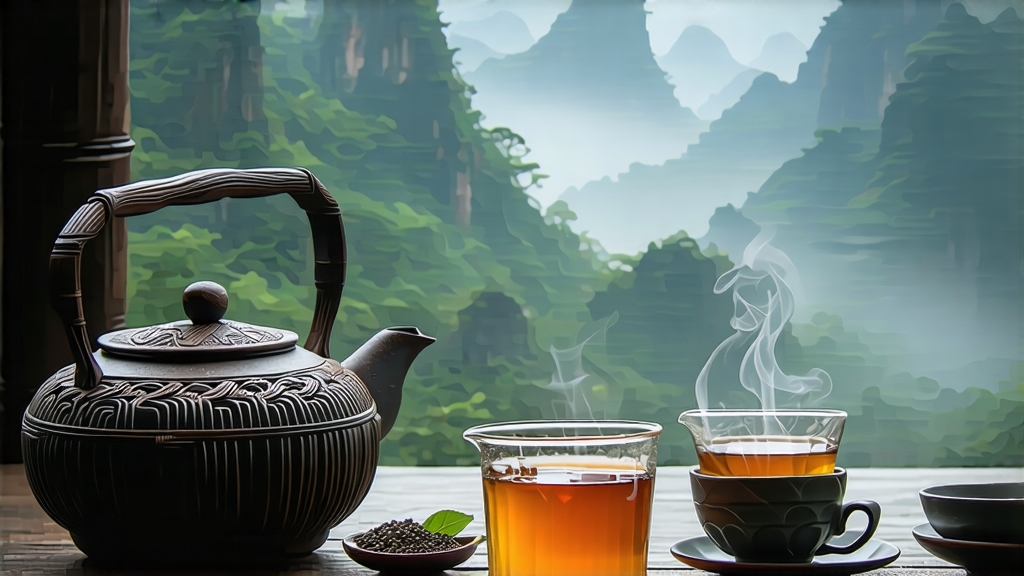
Tucked away in the sinuous river town of Wuzhou, Guangxi, Liupu tea has spent four centuries quietly rewriting the rules of what tea can become. To the uninitiated it is merely another dark brick in the vast Chinese heicha family, yet one sip reveals a personality as layered as the karst peaks that cradle its birthplace. Liupu begins life as a humble summer-harvest Camellia sinensis var. sinensis leaf, but through an alchemy of heat, humidity, time and microbial courtship it transmutes into a liquid antique—inky, medicinal, sweetly resinous—capable of traveling the globe without losing its soul.
Historical whispers first surface in 1687, when a Guangdong merchant recorded “buying pressed Wu-zhou cha for Manila galleons.” By the Qing-era Qianlong reign (1736-1795) Liupu had already shouldered the moniker “tea of the southern frontier,” bartered for horses with Tibetan highlanders and poured in Hong Kong teahouses as a digestif for dockworkers. The name itself is a cartographic echo: Liu-zhou prefecture to the north, Pu-jie wharf to the south—merged by Cantonese traders into one market brand. When British clipper ships later anchored at Whampoa, Liupu bricks were catalogued as “black tea of Kwangsi,” a label that amused locals who knew it was neither red (hong) nor green, but something darker, older, wiser.
Unlike Yunnan’s shou pu-erh which commands global fame, Liupu remains a connoisseur’s secret, produced in micro-batches by seven family workshops whose recipes are oral heirlooms. The tea is classified into three archetypes: San Cha (loose leaf), Lan Cha (basket-pressed) and Zhuan Cha (brick-pressed). Each style shares a terroir signature—low-altitude lateritic soil, subtropical fog, and the Xun River’s mineral-rich silt—but diverges in post-fermentation choreography.
Craft begins on the last day of the Grain-in-Ear solar term, when leaves have grown thick but not yet woody. Pluckers take one bud with the fourth leaf, a grade called “huangpian” that other teas discard. The harvest is carried in bamboo creels to the “liangqing” courtyard where withering lasts only until the edges curl like parchment—about three hours under late-May sun. A 280 °C wok firing follows, shorter than green tea’s kill-green yet longer than oolong’s; masters call this “breaking the green horse but keeping the red foal,” meaning enzymatic oxidation is halted while internal moisture remains high. What happens next is Liupu’s singular pivot: the leaves are piled inside dark bamboo chambers, sprinkled with mineral water drawn from the Dragon Spring, and covered with hemp cloth. Over eighteen nights the pile reaches 58 °C, cooled only by turning, encouraging a bloom of Aspergillus niger and Bacillus subtilis that will later gift the tea its trademark betel-nose aroma. This wet-pile phase is shorter than pu-erh’s wo dui, yielding a lighter fermentation (30–35 % vs 45–50 %) and preserving more catechin backbone for decades of slow aging.
Once the inner leaf vein turns walnut-brown, the tea is steamed for seven seconds, enough to soften without melting the trichomes, then pressed into hand-woven bamboo baskets called “lang.” Each lang holds exactly 37 kg, a unit dating to the horse-caravan era when two baskets formed one porter’s load. The basket’s convex belly allows residual heat to escape downward, preventing sourness while encouraging micro-oxygenation. After three months the bamboo is peeled away, revealing a dark glossy dome imprinted with lattice scars—nature’s bar-code. Bricks (zhuan) are a twentieth-century concession to export crates: hydraulic presses deliver 20 MPa for ninety seconds, producing a density of 0.94 g cm⁻³, tight enough to deter mold yet porous enough for time to breathe.
Aging is where Liupu becomes autobiography. In the humid basements of Wuzhou, seasonal swings between 65 % and 92 % RH act like lungs, drawing the tea into decades-long respiration. The dominant microbes shift every five years: Aspergillus gives way to Penicillium, then to yeasts such as Debaryomyces; each wave leaves a flavor footnote—camphor